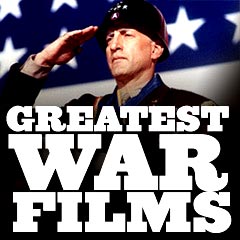
|
Greatest War Movies 1980s |
| Film Title/Year/Director, War-time Setting and Brief Description | ||
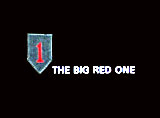
|
The Big Red One
(1980)
Director-writer Samuel Fuller's semi-autobiographical film, based upon his own wartime experiences, was his most expensive - financed and distributed by 20th Century Fox. Fuller was unhappy with the studio's decision to cut the film in half and to add off-screen narration. It captured the terror and physical/mental strain of ill-advised combat of a 12-man foot-soldier's squadron in the US Army's First Infantry Division (its insignia was dubbed 'The Big Red One') and its intrepid sergeant Possum (played by Lee Marvin) during WWII. It followed their progress (as they were whittled down to four men) from North Africa through Sicily, Omaha Beach and Belgium to the ultimate horror of the concentration camp ovens at Falkenau, Czechoslovakia. |
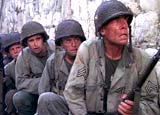
|
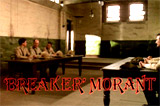
|
Breaker Morant (1980, Australia)
Australian director Bruce Beresford's Oscar-nominated courtroom drama was set during a period of British imperialism. Its plot was similar to Kubrick's Paths of Glory (1957), and it starred English actor Edward Woodward as one of the ill-fated soldiers, Anglo-Australian horseman Harry "Breaker" Morant. Its tagline proclaimed: "HERO OR VILLAIN ...his exploits shook an empire...and made him a legend." It told the story of three Australian Army lieutenants-soldiers in the Boer War at the turn of the century, as members of the Bushveldt Carbineers, who were scapegoated and placed on trial for court-martial for shooting POW's during warfare. They were executed by firing squad by film's end, to which Morant commented: "this is what comes from empire building!" |
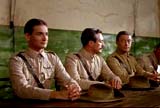 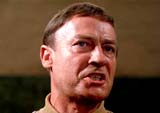
|
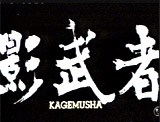
|
Kagemusha, The Shadow Warrior (1980, Jp.)
Director Kurosawa's Oscar-nominated epic war film was set during feudal Japan when warring factions battled for the capital city of Kyoto. Kagemusha, meaning "shadow warrior" or impersonator, was personified by lower-class petty thief (Tatsuya Nakadai), who was saved from execution by crucifixion so he could impersonate dying war lord Takeda Shingen (also Nakadai). The charade worked for awhile, until he was unmasked while unable to control Shingen's steed. Shingen's son Katsuyori (Kenichi Hagiwara) took over the clan, and foolishly led them in the film's climactic and bloody Battle of Nagashino which contrasted samurai-warrior fighting with more modern tactics and firearms. The loyal kagemusha, during the slaughter, took up a lance on the side of the clan and futily charged against the enemy. |
  
|

|
Das Boot (1981,
Germany) (aka translated The
Boat)
German director Wolfgang Petersen's sympathetic and realistic, expensively-made anti-war film was faithfully adapted from the autobiographical book by war correspondent Lothar-Guenther Buchheim. It followed the heroic efforts of a German U-boat captain (Jurgen Prochnow), known as der Alte ("the Old Man") and its crew during WWII to patrol the Atlantic and Mediterranean within the claustrophic, cramped confines of their undersea vessel (U-96). The harrowing and tense film included scenes of depth charge attacks, rivets popping during a deep dive maneuver, hull breaches that let in water, and the threats of asphyxiation and starvation. |

|
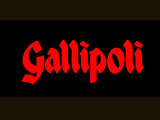
|
Gallipoli (1981,
Australia)
Director Peter Weir's heart-wrenching, anti-war Australian film was set during WWI. It was a rich character study of two idealistic best friends (and sprinters) in the Australian army who would vainly fight the German-allied Turks at Gallipoli in 1915. The film ended with an ill-fated suicidal charge of soldiers on the Anzac battlefield. Message running soldier Frank Dunne (Mel Gibson) frantically sprinted to the front line, but arrived just a few moments too late. He let out a scream of despairing anguish, knowing friend Archy Hamilton (Mark Lee) and other companions were going to be senselessly killed because of miscommunications and bad timing. It ended with a freeze-frame image of Archy at the instant of his death when riddled by bullets - the image slowly faded to black to conclude the film. |
 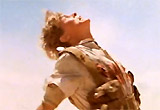
|
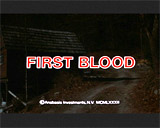
|
First Blood (1982)
Sylvester Stallone appeared in the 'feel-good' action/war Rambo 'trilogy' (and a fourth film 20 years later) - with this first film being the best of the series. His character was a misfit, cartoonish, and self-righteous super-hero - a revenge-seeking, buffed up, brooding ex-Green Beret Vietnam veteran (of Special Operations Command) named John Rambo. He 'refought' the Vietnam War as a 'one-man army,' using VC bushwhacking techniques, during his battle against a variety of enemies in the Pacific Northwest, including small-town sheriff Will Teasle (Brian Dennehy), a posse, and hundreds of National Guardsmen. |
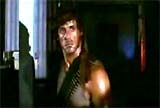
|
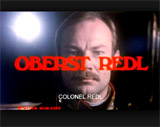
|
Colonel Redl
(1985, Hung/Aust/W. Germ.) (aka Oberst
Redl) (Hungarian: Redl Ezredes)
This Hungarian film, a nominee for Best Foreign Language Film, was adapted from British playwright John Osborne's 1966 play A Patriot for Me. It was set during the time of the Austro-Hungarian Empire and told the life story (and fall from grace) of the title military character, Colonel Alfred Redl (Klaus Maria Brandauer). He was in the Royal Imperial Austrian Army stationed on the Russian border where he ambitiously rose to the rank of colonel. When the Austro-Hungarian Empire began to crumble, he was promoted to be in charge of internal military intelligence in Vienna, Austria where he became more and more disenchanted by the Empire under the rule of war-hungry Archduke Franz Ferdinand (Armin Mueller-Stahl). In the end, Redl committed suicide (rather than being revealed as a homosexual and a spy) after expressing his opposition to the corruption of the monarchy and becoming a victim of his own blackmailed secrets, concurrent with the Archduke's assassination in Sarajevo - the trigger point for WWI. |

|
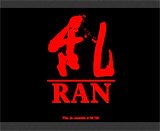
|
Ran (1985, Jp.)
The title of writer/director Akira Kurosawa's lavishly-produced and masterful film literally meant 'war,' 'chaos,' or 'revolt.' This expensive film was the legendary director's last great epic, receiving an Academy Award for Best Costume Design. It was a loose adaptation of the story of Shakespeare's tragedy King Lear, set in feudal Japan. It was the tale of a powerful and greedy aging warlord Hidetora Ichimonji (Tatsuya Nakadai), whose treacherous rise to power left him insane, deranged and haunted by the souls he had slain. After ceding his property and power to his three sons, war broke out within his clan due to sibling rivalry. The Ichimonji kingdom ended with the death and destruction of the entire family and the Great Lord himself, as surrounding clans took advantage of the situation. |
 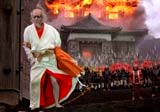 
|
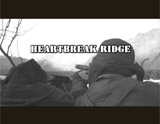
|
Heartbreak Ridge (1986)
Actor-producer-director Clint Eastwood's film depicted an aging, grizzled Marine gunnery sergeant named Thomas "Gunny" Highway (Eastwood himself) whose days in the military were numbered. He was redeemed with one final chance to train a green, rag-tag "recon" platoon with old-fashioned discipline ("When you start looking like Marines, you'll start feeling like Marines, and pretty soon, goddammit, you'll start acting like Marines"). Gunny used unorthodox training methods in order to invade and become victorious over the tiny island of Grenada in 1983. |
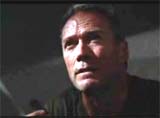 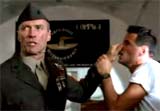 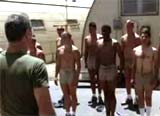
|

|
Platoon (1986)
This ultra-realistic, gutsy and insightful Best Picture-winning film was one of the finest, most-acclaimed combat films ever produced regarding the Vietnam War. Director Stone's semi-autobiographical tale was about the testing of young infantryman Chris Taylor (a star-making role for Charlie Sheen) in the 25th Infantry (Bravo Company) by his two superiors as they conducted various patrols and ambush missions. It contrasted the two Sergeants (one good and one evil) - tough, compassionate Sergeant Elias Grodin (Willem Dafoe) and hard/callous, sociopathic, facially-scarred Staff Sergeant Bob Barnes (Tom Berenger). The popular film won four Oscars, including Best Picture, and indelibly portrayed Elias' death in a crucifixion pose on his knees as he was mortally wounded by Vietcong soldiers when he emerged from the jungle. |
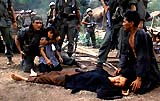  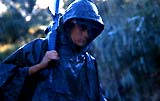 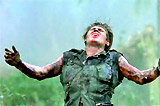
|

|
Full Metal Jacket (1987)
Director/co-writer Stanley Kubrick's adaptation of Gustav Hasford's 1979 novel The Short Timers was in two parts. The film presented the exploits of a recruited young Marine Corps soldier known as Private / Sergeant James T. "Joker" Davis (Matthew Modine), in two sections:
The film ended with the unit marching through burned out ruins singing "The Mickey Mouse Club" theme song, as 'Joker' narrated (voice-over): "I am so happy that I am alive, in one piece and short. I'm in a world of s--t - yes. But I am alive. And I am not afraid." |
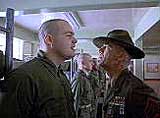 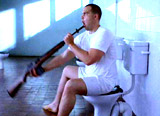 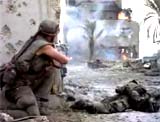 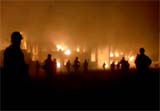
|
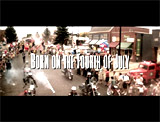
|
Born on the Fourth of July (1989)
This was the true story of gung-ho patriotic Marine enlistee Ron Kovic (Tom Cruise), a star wrestler and all-American athlete, who was severely wounded during his second tour of duty in Vietnam in early 1968. He spent many months recuperating and bedridden at the Bronx Veterans Administration Hospital, where he suffered from poor and "indecent" treatment, unavailability of doctors, and a deplorable physical state. He finally returned home, newly-paralyzed from the waist-down, in 1969, and showed signs of PTSD (post-traumatic stress disorder). He felt angry, betrayed, anguished, and helpless, became very disillusioned about the progress of the war, and took to drinking. In a wheelchair as a paraplegic, he made a scene as an anti-war veteran and belligerent political activist (in Vietnam Veterans Against the War) at the 1972 Republican National Convention in Miami during Nixon's acceptance speech. In the concluding scene, Kovic was wheeled into the 1976 Democratic National Convention, now hailed and honored as a real hero after the publication of his autobiography (Born on the Fourth of July) - the basis for the film itself. |
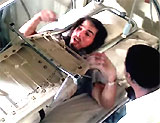 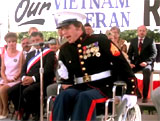 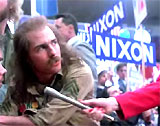 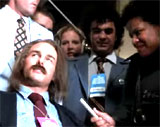
|
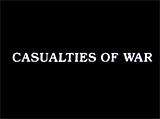
|
Casualties of War (1989)
This thought-provoking war film emphasized the dehumanizing effects of battle on soldiers. In flashback, it told the true story (from a New Yorker article by Daniel Lang) of decent Army Private First Class Max Eriksson (Michael J. Fox). He refused to overlook his squadron's moral responsibility (over the objections of squad leader, Sergeant Tony Meserve (Sean Penn)), for the retaliatory kidnap, sexual assault/gang rape, and murder of a native Vietnamese girl (Than Thi Oanh (Thuy Thu Le)) during the conflict. The film also followed the attempted coverup afterwards. |
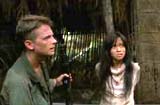 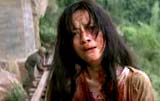
|

|
Glory (1989)
One of the very best, fact-based Civil war films, this one was based upon the historical novels Lay This Laurel by Lincoln Kirstein and One Gallant Rush by Peter Burchard. Denzel Washington won his first Oscar for the role of rebellious ex-slave Trip. It depicted the overlooked but brave and distinguished participation of all-volunteer, African-American soldiers on the side of the Union in the first all-black 54th Regiment of the Massachusetts Volunteer Infantry (composed of runaway slaves and northern "freemen"). The film was based on the letters of the 600-man regiment's idealistic, 25-year old white commander, Robert Gould Shaw (Matthew Broderick) from a privileged, abolitionistic family in Boston. The film focused on the hard training and the troops' battle to earn credibility with prejudiced military authorities to actually demonstrate their courage and determination during combat. The movie climaxed with their final, suicidal assault in 1863 on the impregnable Fort Wagner near Charleston, South Carolina - it failed (and both Shaw and Pvt. Trip (Denzel Washington) died and were buried together in a mass beach grave), but ultimately turned the tide of the war. |
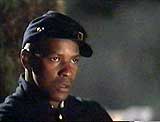 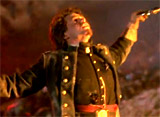 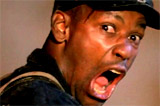 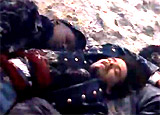
|
(chronological by film title) Introduction | 1900s-1920s | 1930s | 1940s-1 | 1940s-2 | 1950s | 1960s-1 | 1960s-2 | 1970s | 1980s | 1990s | 2000s | 2010s |